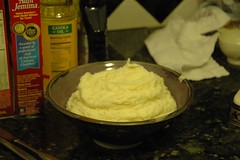Pigs (ergo, men) are smart!

Or at least, so Natalie Angier reports in the New York Times:
We’ve all heard the story of the third Little Pig, who foiled the hyperventilating wolf by building his house out of bricks, rather than with straw or sticks as his brothers had done. Less commonly known is that the pig later improved his home’s safety profile by installing convex security mirrors at key points along the driveway.
Well, why not? In the current issue of Animal Behaviour, researchers present evidence that domestic pigs can quickly learn how mirrors work and will use their understanding of reflected images to scope out their surroundings and find their food...
[...]
The finding is just one in a series of recent discoveries from the nascent study of pig cognition. Other researchers have found that pigs are brilliant at remembering where food stores are cached and how big each stash is relative to the rest. They’ve shown that Pig A can almost instantly learn to follow Pig B when the second pig shows signs of knowing where good food is stored, and that Pig B will try to deceive the pursuing pig and throw it off the trail so that Pig B can hog its food in peace.
They’ve found that pigs are among the quickest of animals to learn a new routine, and pigs can do a circus’s worth of tricks: jump hoops, bow and stand, spin and make wordlike sounds on command, roll out rugs, herd sheep, close and open cages, play videogames with joysticks, and more. For better or worse, pigs are also slow to forget. “They can learn something on the first try, but then it’s difficult for them to unlearn it,” said Suzanne Held of the University of Bristol. “They may get scared once and then have trouble getting over it.”
[...]
...Even on a cursory glance, “the pig genome compares favorably with the human genome,” said Lawrence Schook of the University of Illinois at Urbana-Champaign, one of the team leaders.
“Very large sections are maintained in complete pieces,” he said, barely changed in the 100-million-plus years since the ancestors of hogs and humans diverged.
Dr. Schook is particularly eager to see if the many physiological and behavioral parallels between humans and pigs are reflected in our respective genomes. Pig hearts are like our hearts, he said, pigs metabolize drugs as we do, their teeth resemble our teeth, and their habits can, too. “I look at the pig as a great animal model for human lifestyle diseases,” he said. “Pigs like to lie around, they like to drink if given the chance, they’ll smoke and watch TV.”


0 Comments:
Post a Comment
<< Home